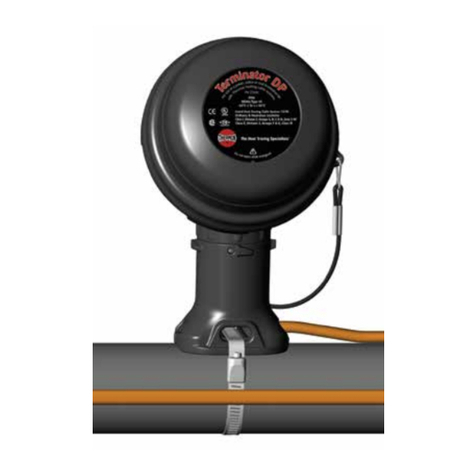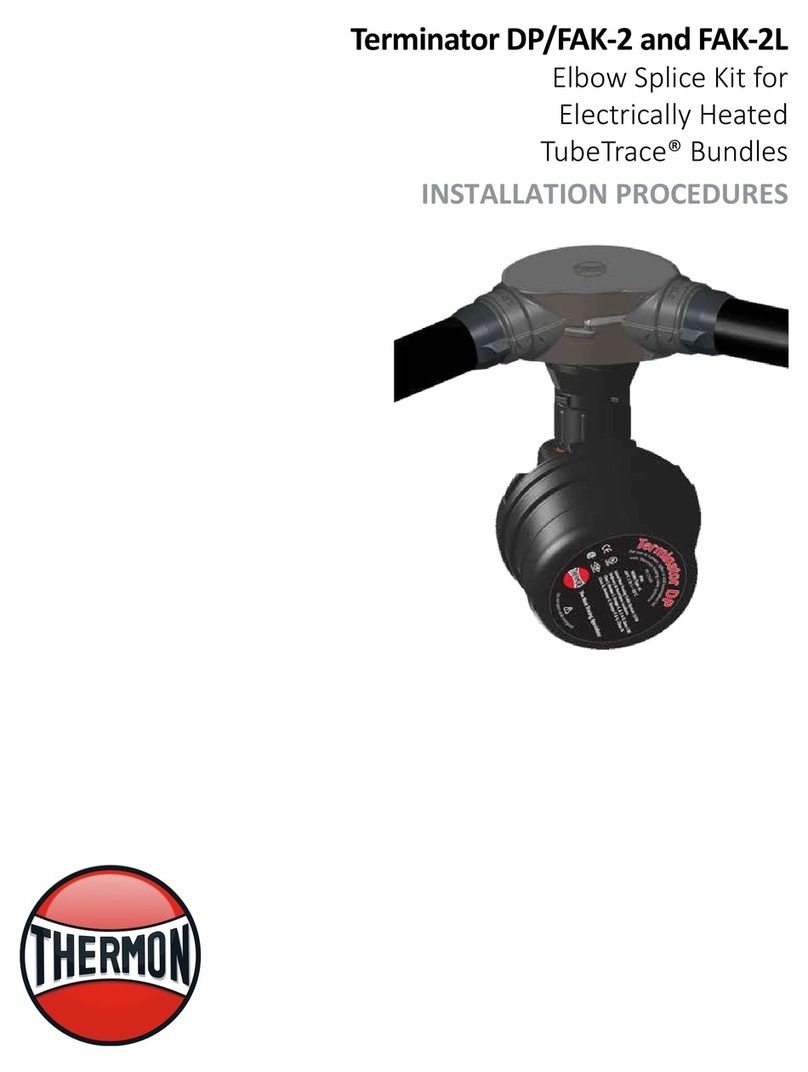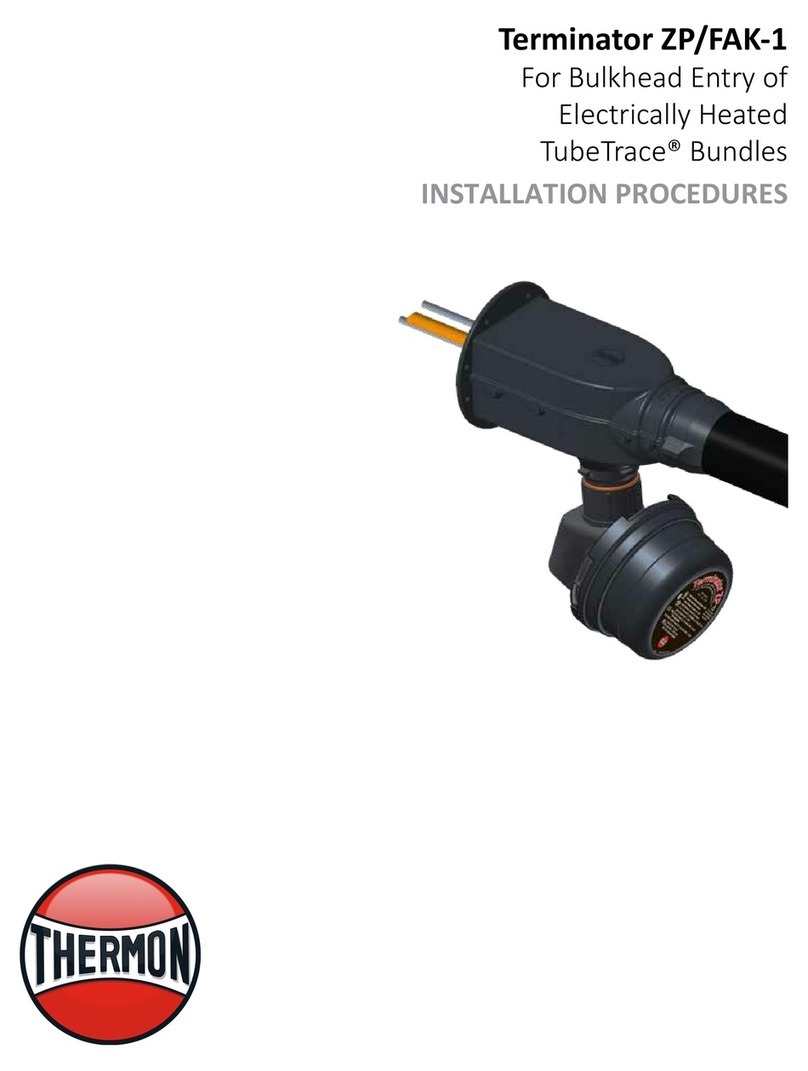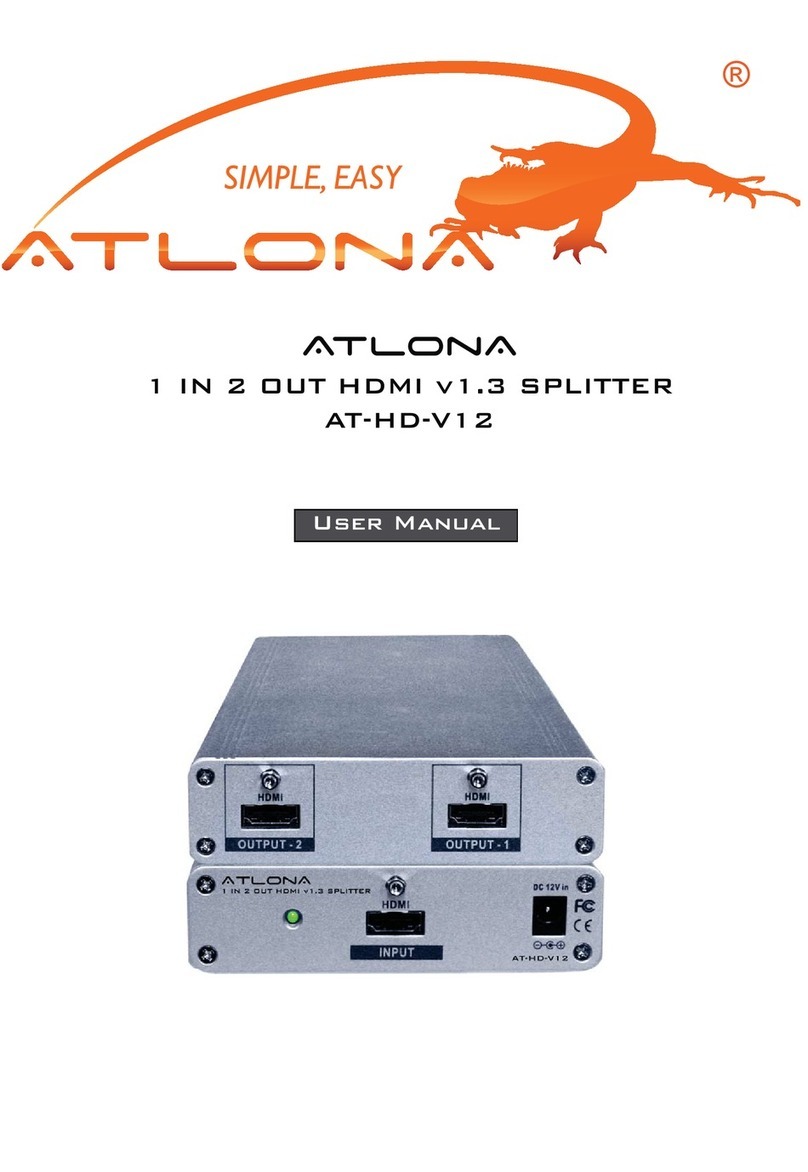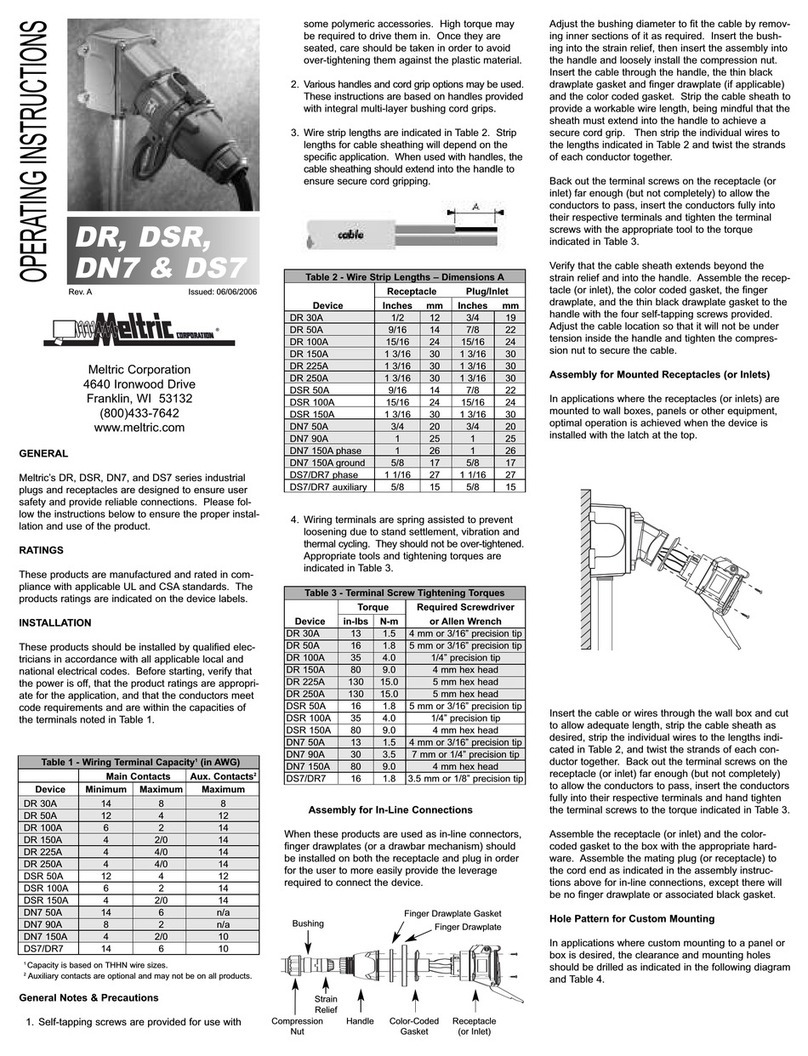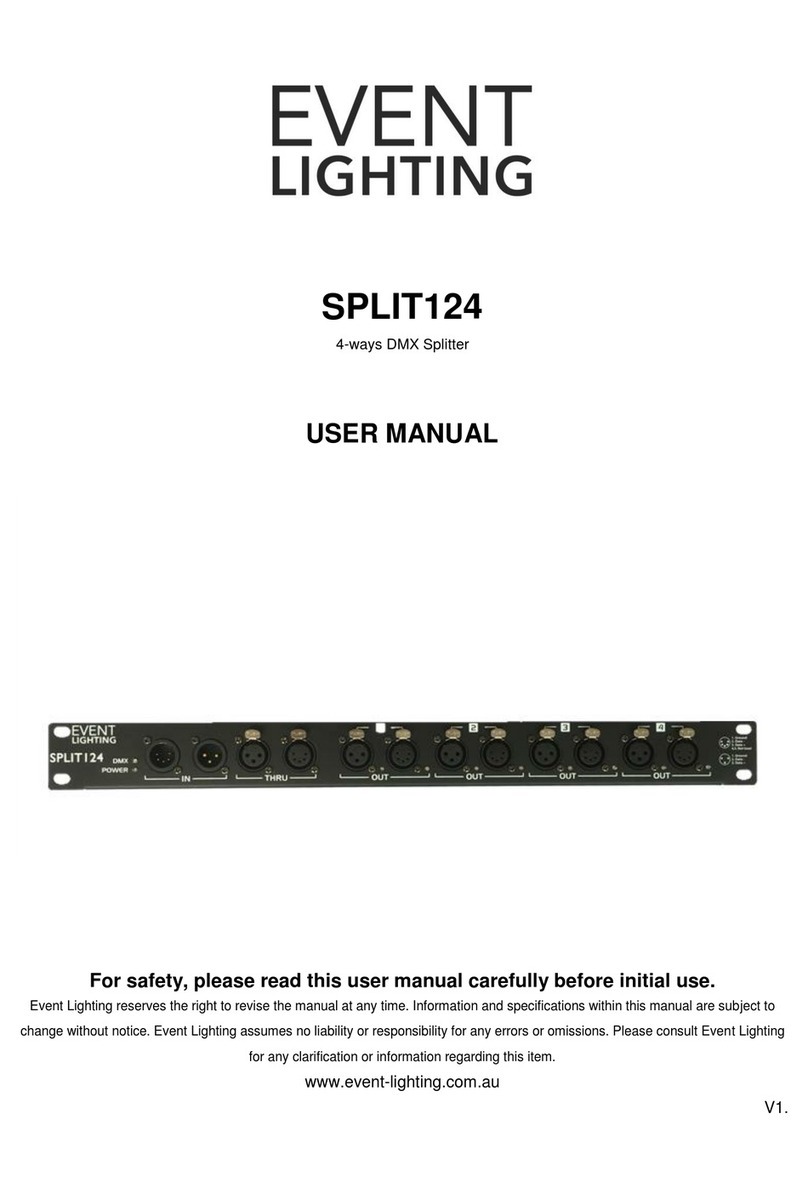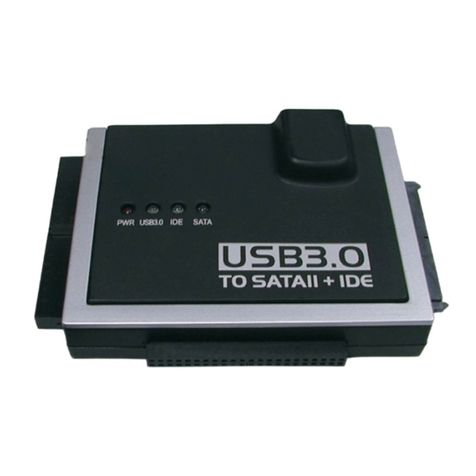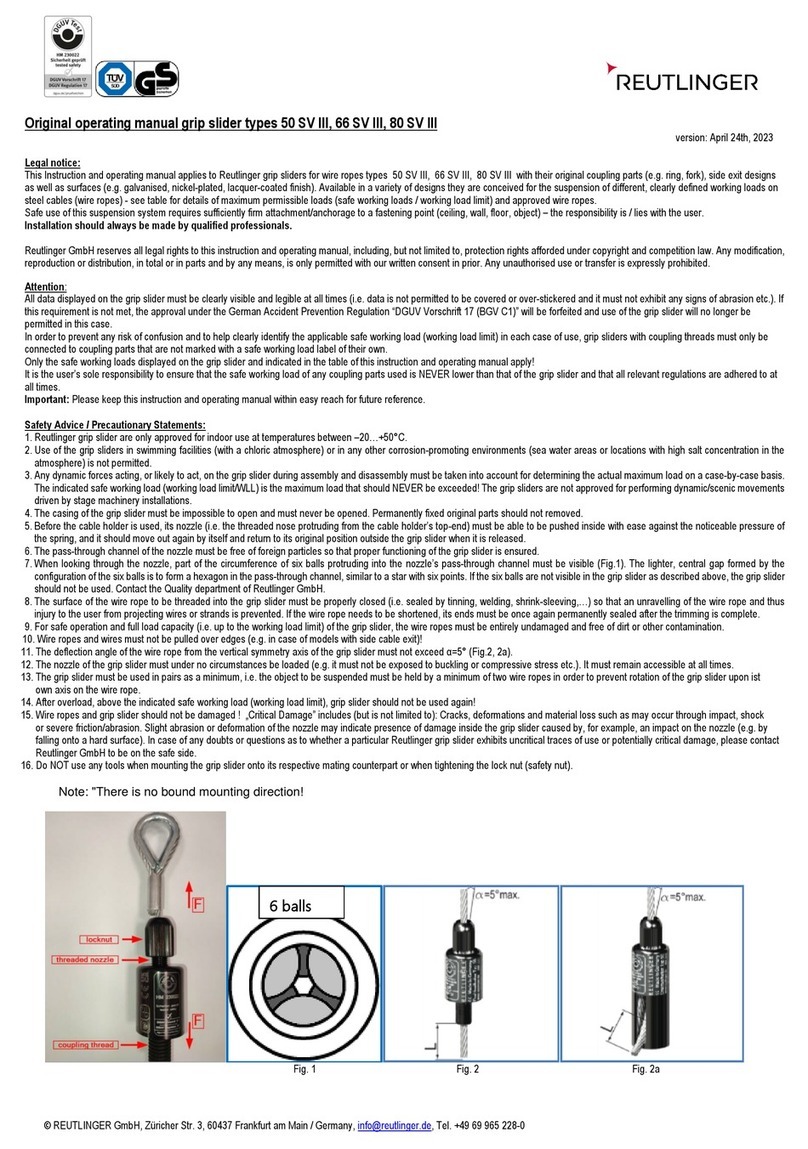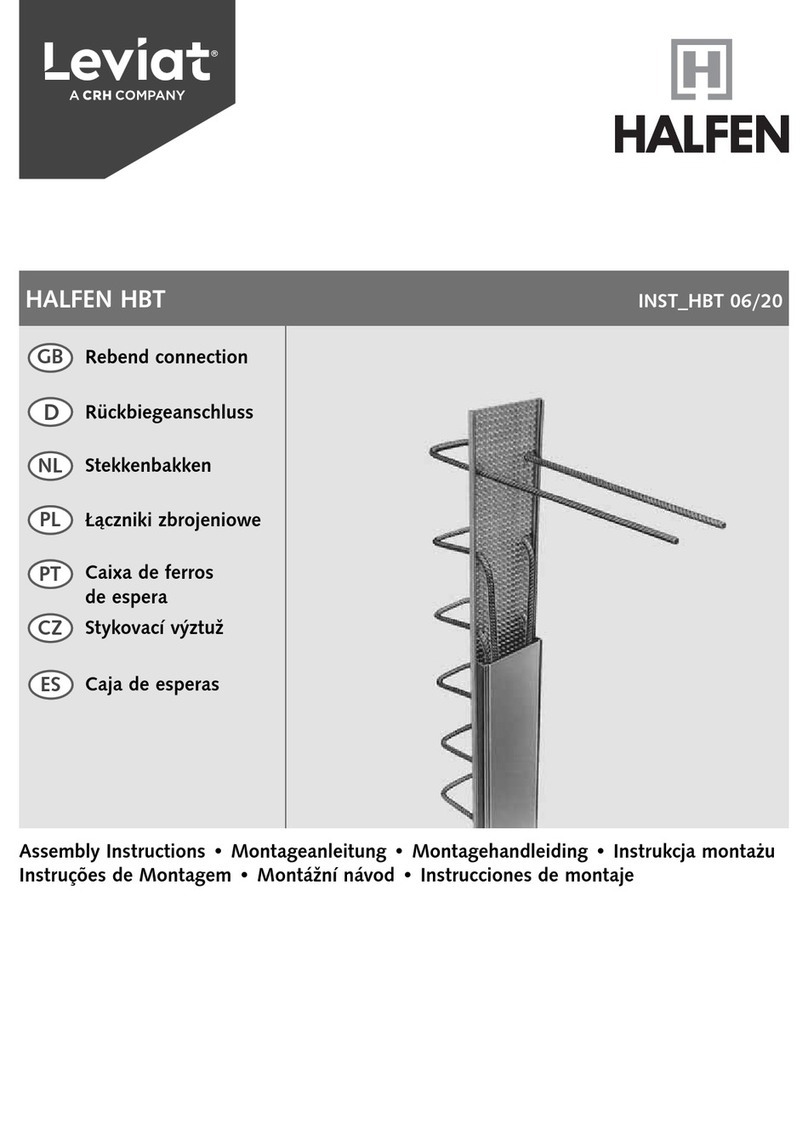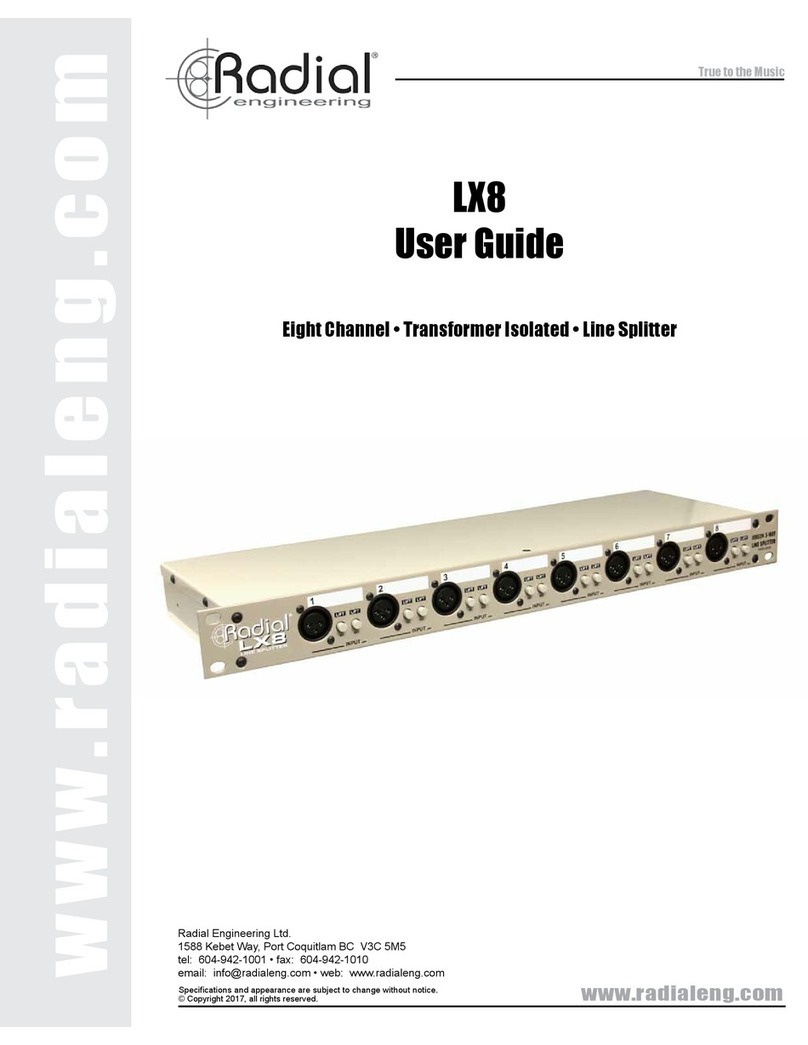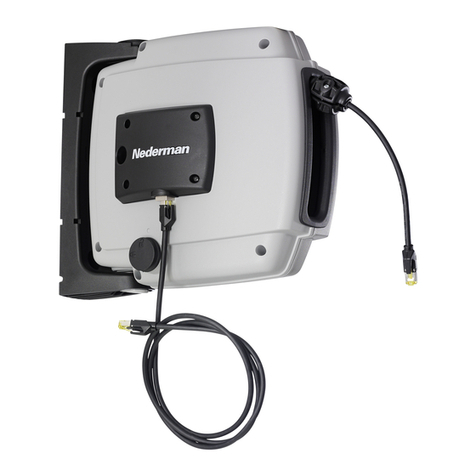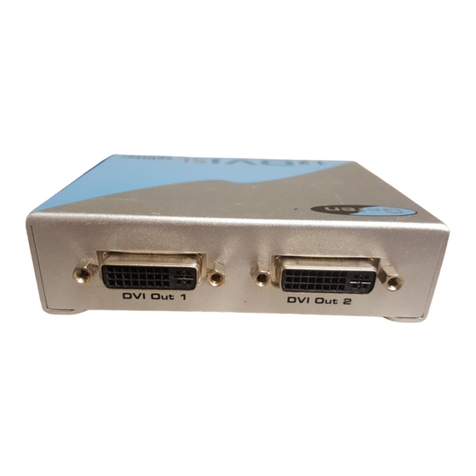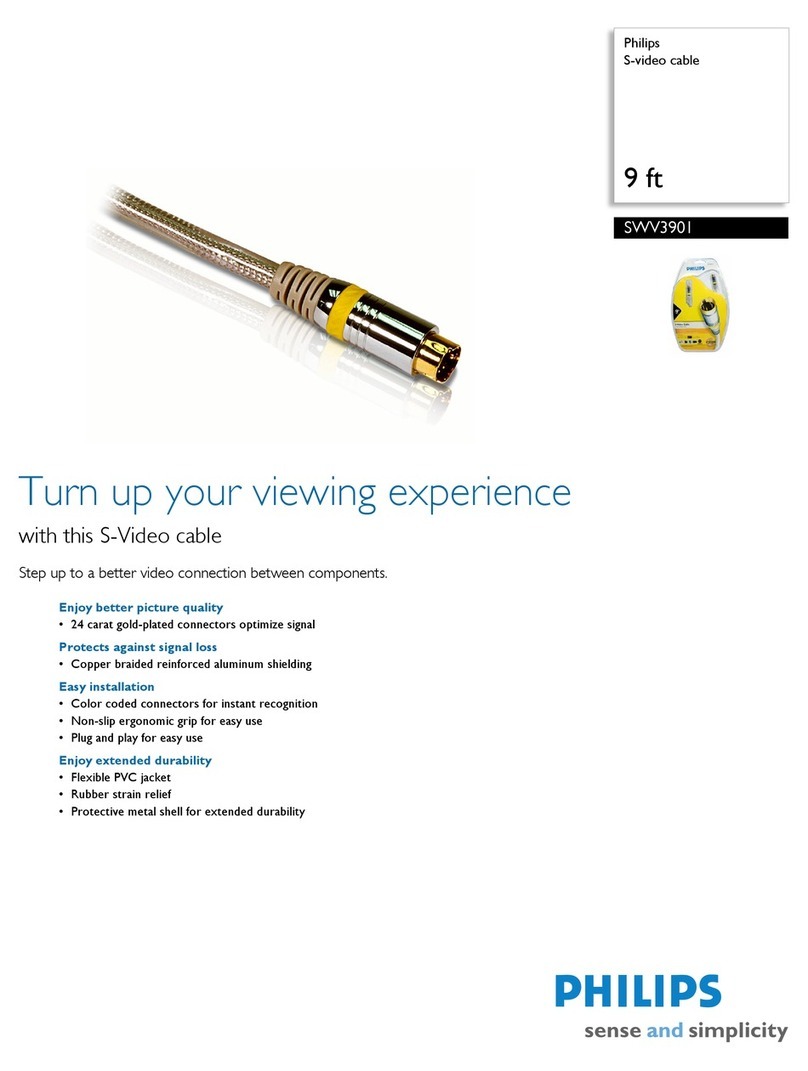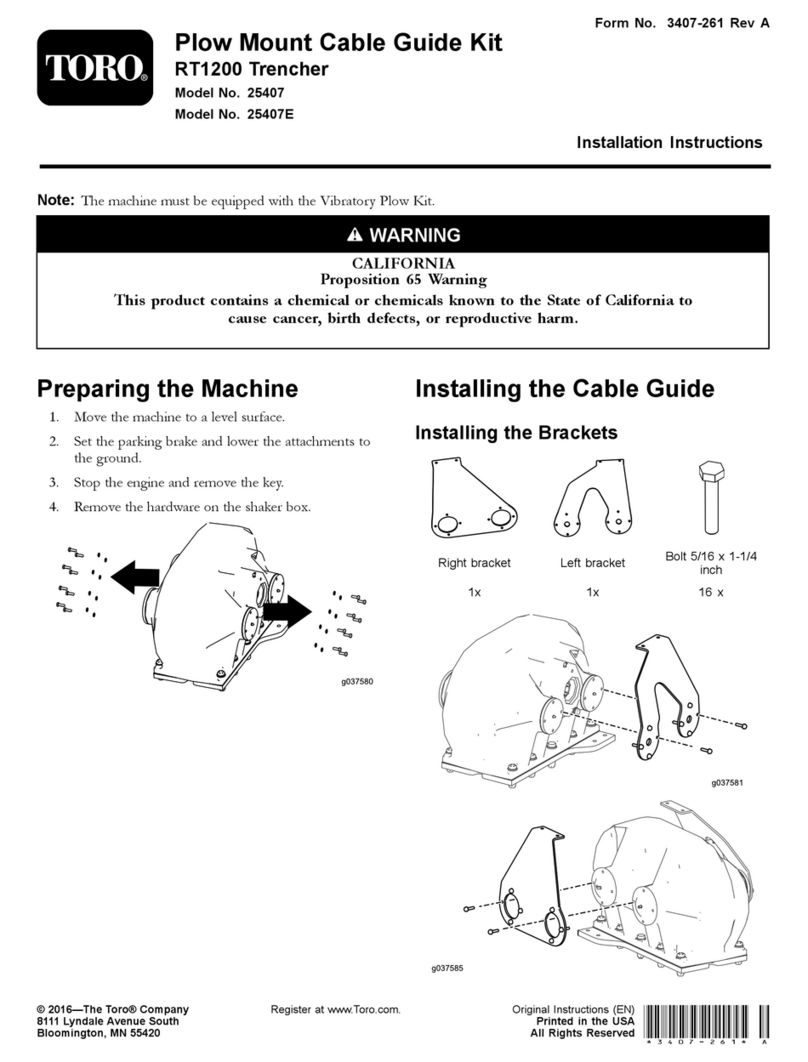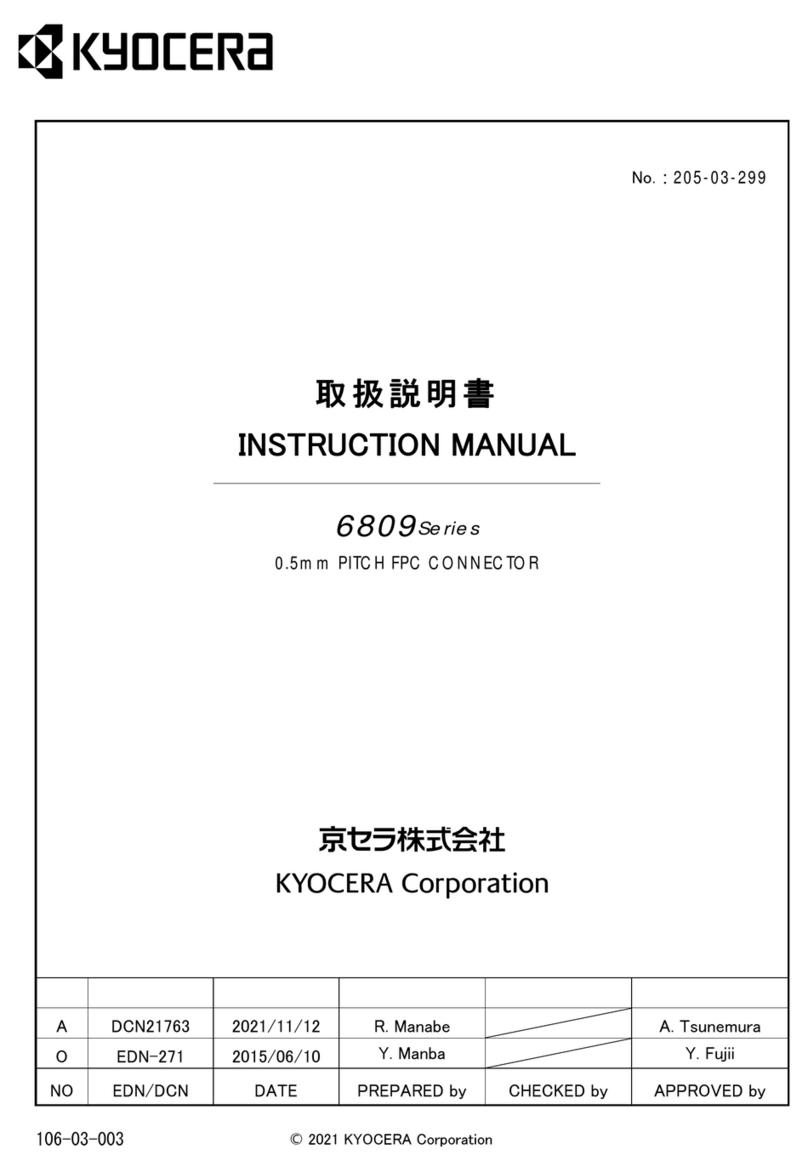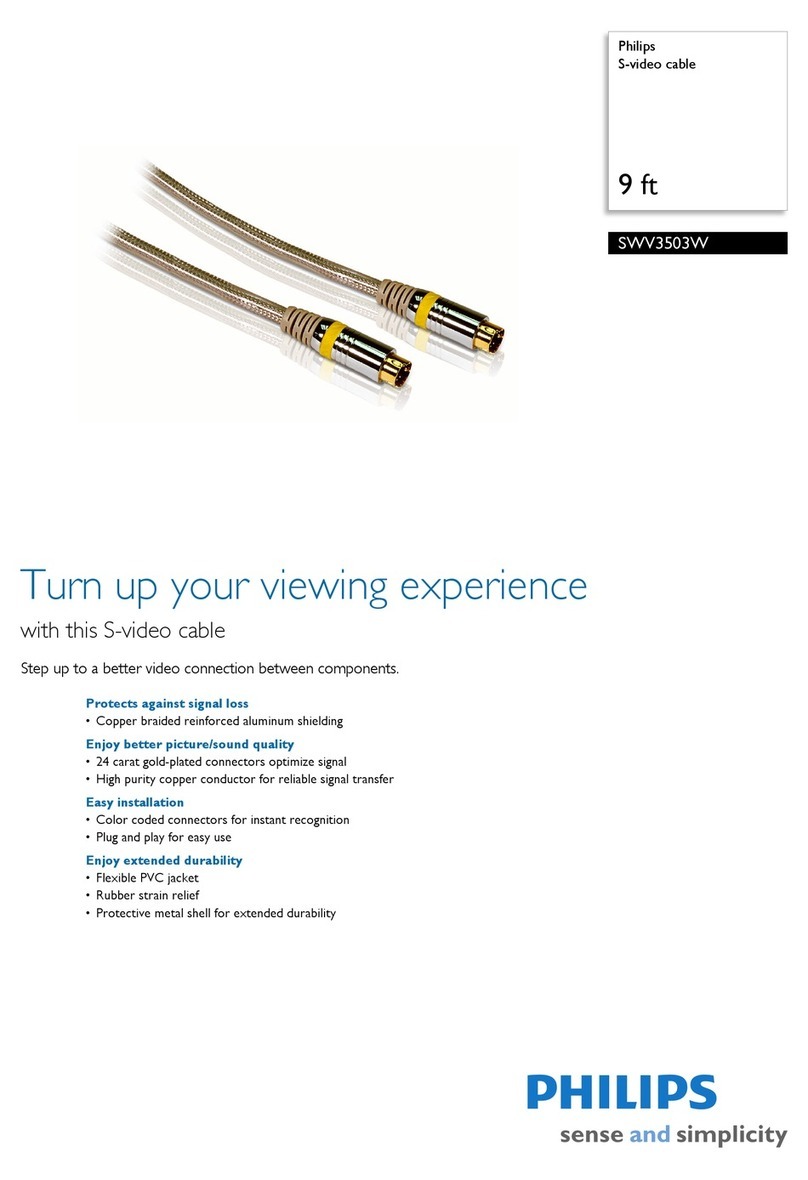Thermon FLX Self-Regulating Reference guide

FLXTM Self-Regulating
Winterization/Freeze Protection
INSTALLATION PROCEDURES

FLXTM Self-Regulating
Typical Heat Tracing Installation . . .
A complete electric heat tracing system will typically in-
clude the following components:
1. Electric heat tracing
cable.
2. Power connection kit.
3. Control thermostat (may
be remote ambient
sensing control.)
4. In-line/T-splice
kit (permits two
or three cables to
be spliced together).
5. Cable end termination.
6. Attachment tape (use on 12”
intervals or as required by code
or specication).
7. “Electric Heat Tracing”label (peel-and-stick
label attaches to insulation vapor barrier
on 10’ intervals or as required by code or
specication).
8. Thermal insulation and vapor barrier
(by others).
The absence of any of these items
can cause a system to malfunction
or represent a safety hazard.
FLXTM Self-Regulating
Before Installing Cable . . .
1. Be sure all piping and equipment to be traced is completely
installed and pressure tested.
2. Surface areas where heat tracing is to be installed must be
reasonably clean. Remove dirt, rust and scale with a wire
brush and oil and grease lms with a suitable solvent.
Refer to the“FLX Cable Testing Report” for required recording
of test data and circuit information.
Upon Receiving Cable . . .
1. Upon receiving heating cable, check to make sure the proper
type and output have been received. All cables are printed
on the outer jacket with part number, voltage rating and watt
output.
2. Visually inspect cable for any damage incurred during ship-
ment. The heating cable should be tested to ensure electri-
cal integrity with at least a 500 Vdc megohmmeter (meg-
ger) between the heating cable bus wires and the heating
cable metallic braid. IEEE 515.1 recommends that the test
voltage for polymer insulated heating cables be 2500 Vdc.
Minimum resistance should be 20 megohms. (Record 1 on
Cable Testing Report.)
Connect the positive lead of the megger to the cable bus
wires and the negative lead to the metallic braid.
CAUTION: DO NOT connect power to heating
cable while it is on reel or in shipping carton.
The National Electric Code and Canadian Electrical
Code require ground-fault protection be provided
for all electric heat tracing.
6
5
4
8
71
2
3
2

INSTALLATION PROCEDURES
3
2. Make heating cable allowances for valves, anges, elbows
and supports as per the applicable drawings and table on
pages 2 and 3 of these installation procedures. See product
specications sheet for heating cable minimum bend radius.
Temporary Installation Proposed End-of-Circuit
Location
Proposed Power
Connection Location
Pipe Support
Cable Allowance for
In-Line Heat Sinks
Initial Installation . . .
1. Begin temporary installation at the proposed end-of-circuit
location and lay out heating circuit on the pipe, allowing ex-
tra cable for the power connection and for any splice loca-
tions. Refer to illustration below for temporary installation.
Installation on Fittings and Equipment . . .
1. Install heating cable in accordance with illustrations below.
Secure heating cable to piping using attachment tape.
2. Elbows: Locate the cable on the outside radius of an elbow
to provide sucient heat to compensate for the added pip-
ing material. Secure the cable to the pipe on each side of
the elbow with attachment tape.
Attachment Tape
(Typical)
Heating Cable
Pipe Elbow Pipe Support
Support
Length
Attachment Tape
(Typical)
Heating Cable
3” Min.
(8 cm)
3” Min.
(8 cm)
3. Pipe Supports: Insulated pipe supports require no additional
heating cable. For uninsulated supports, allow two times the
length of the pipe support plus an additional 15”(40 cm) of
heating cable.

FLXTM Self-Regulating
4
Table 1: Valve and Pump Allowances
Heating Cable
12” Max.
(30 cm)
Note:
Flange allowance will vary based on method of insulating ange and adjacent piping.
4. Flanges: Allow cable to be looped around pipe on each side
of and adjacent to the ange. Heating cable must maintain
contact with ange when bending around pipe anges to
compensate for additional heat loss.
Attachment Tape
(Typical)
Heating Cable
Temporary Loop of Cable on Valve
Attachment Tape
(Typical)
Heating Cable Serpentined on Pump
Heating Cable Attachment Tape
(Typical)
Heating Cable Serpentined on Valve
Typical Pump Detail
Heating Cable Attachment Tape
(Typical)
Pipe
Size
Valve Type
Screwed Flanged Welded
Pump Type
Screwed Flanged
½" 6" 1' 0 1' 2'
¾" 9" 1'-6" 0 1'-6" 3'
1" 1' 2' 1' 2' 4'
1¼" 1'-6" 2' 1' 3' 4'-6"
1½" 1'-6" 2'-6" 1'-6" 3' 5'
2" 2' 2'-6" 2' 4' 5'-6"
3" 2'-6" 3'-6" 2'-6" 5' 7'
4" 4' 5' 3' 8' 10'
6" 7' 8' 3'-6" 14' 16'
8" 9'-6" 11' 4' 19' 22'
10" 12'-6" 14' 4' 25' 28'
12" 15' 16'-6" 5' 30' 33'
14" 18' 19'-6" 5'-6" 36' 39'
16" 21'-6" 23' 6' 43' 46'
18" 25'-6" 27' 6'-6" 51' 54'
20" 28'-6" 30' 7' 57' 60'
24" 34' 36' 8' 68' 72'
30" 40' 42' 10' 80' 84'
6. Install heating cable on valves and pumps utilizing a looping
technique (this allows the valve or pump to be removed if
required).
5. Additional cable is required to provide extra heat at valves,
pumps and miscellaneous equipment to oset the in-
creased heat loss associated with these items. Refer to
Table 1 for estimated cable requirements for installation on
typical valves and pumps.
Typical Valve Details
Typical Flange Detail

INSTALLATION PROCEDURES
5
Completing the Installation . . .
1. Begin nal cable attachment by securing the end-of-circuit
termination kit and working back toward the power supply.
• Flexible heating cables are to be installed using attachment
tape. Circumferential bands of tape should be installed at
12” (30 cm) intervals to keep the cable in proper contact
with the pipe. Refer to Table 2 below to calculate the num-
ber of rolls of attachment tape required based on the pipe
diameter1.
• If applicable, refer to installation details provided with the
project drawings or contactThermon for additional infor-
mation regarding installation.
2. In addition to the circumferential tape requirements, a
continuous covering of aluminum foil tape may be required
when:
• Spray or foam urethane2thermal insulation is applied.
• Heat tracing nonmetallic piping.
• Design requirements dictate the use of aluminum tape to
improve heat transfer.
3. Complete splice connections (if required) in accordance
with the installation instructions provided with the splice kit.
4. Install power connection kit in accordance to the detailed
installation instructions provided with the kit.
5. Before making power connections, repeat the megger test
with at least a 500 Vdc megohmmeter (megger) between
the heating cable bus wires and the heating cable metallic
braid. IEEE 515.1 recommends that the test voltage for
polymer insulated heating cables be 2500 Vdc. The mini-
mum acceptable level for the megger reading for any
polymer-insulated heat tracing cable is 20 megohms.
(Record 2 on Cable Testing Report)
Heating Cable vs. Sensor Location
Temperature Control . . .
1.
When a line sensing controller is specied, the sensor should
be placed at least 90° around the circumference from the
heating cable, or at least 2" (5 cm) from the cable.
Tape
Length
Pipe Diameter in Inches
½"-1" 1¼" 1½" 2" 3" 4" 6" 8" 10" 12" 14" 16" 18" 20" 24" 30"
36 yd 130' 115' 110' 95' 75' 65' 50' 40' 35' 30' 26' 23' 21' 19' 16' 13'
60 yd 215' 195' 180' 160' 125' 105' 80' 65' 55' 50' 43' 38' 35' 31' 27' 22'
Heating Cable
(Typical)
Temperature
Sensor
Table 2: Attachment Tape (Value Represents Approximate Linear Pipe Length Allowance Per Roll)
Ambient Sensing Thermostat
End Termination
Power Connection
L1
L2/N
Ambient Sensing Control Connection
Temperature Sensor End Termination
Power Connection
L1
L2/N
Heating Cable
Pipewall Sensing Control Connection
Heating Cable
3. When using an ambient sensing temperature controller, the
mounting location should be representative of the coldest
region, and the sensing element should not be exposed to
direct sunlight or any additional heat source.
Notes . . .
1. Table 2 assumes circumferential bands every 12” (30 cm) along the length of the piping.
2. Verify exposure temperature of heating cable versus curing temperature of insulation.
2. For pipewall sensing thermostatic control, the heating circuit
is to be connected in series with the control contacts as
shown in illustration below.The pipewall sensing thermostat
may require more than one support point.
90°
Optional Third
Heating Cable
Optional Second
Heating Cable

FLXTM Self-Regulating
6
Final Inspection and Documentation . . .
1. It is recommended that the circuit be temporarily energized
so that the volts, amps, pipe temperature and ambient
temperature may be recorded. This information may be of
value for future reference and should be maintained for the
historical operating data log (Record 4 on Cable Testing
Report).
2. Once power is connected but before putting the system
into operation, verify all heating cable testing and documen-
tation have been completed for each heat tracing circuit.
This will ensure that the system has been installed per the
manufacturers recommendations.
The National Electric Code and Canadian Electrical
Code require ground-fault protection be provided
for branch circuits supplying electric heat tracing
on xed outdoor electric de-icing and snow-melt-
ing equipment.
Thermal Insulation . . .
1. The need for properly installed and well-maintained thermal
insulation cannot be overemphasized. Without insulation,
heat losses are generally too high to be oset by a conven-
tional heat tracing system.
2. In addition to piping and in-line equipment such as pumps
and valves, all heat sinks must be properly insulated. This
includes pipe supports, hangers, anges and, in most cases,
valve bonnets.
3. Regardless of the type or thickness of insulation used, a
protective barrier should be installed. This protects the
insulation from moisture intrusion, physical damage and
helps ensure the proper performance of the heat tracing
system. Seal around all penetrations through the thermal
insulation.
4. After the installation of the thermal insulation and weather
barrier but BEFORE ENERGIZING THE HEATING CIRCUIT,
the megohmmeter test should be repeated.This should call
attention to any damage to the heating cable that may have
occurred during the insulation installation. (Record 3 on
Cable Testing Report)
5. Apply caution labels to insulation weather barrier at required
intervals along pipe
Thermal Insulation with Weather Barrier
Heating Cable
(Typical)
Temperature
Sensor
Weather
Barrier
Thermal
Insulation

FLX™ Cable Testing Report
1. Refer to Thermon FLX Installation Procedures, FORM CPD1018, for general installation procedures, requirements and guide-
lines.
2. Upon receiving heating cable, check the cable to make sure the proper type and output have been received. All cables are
printed on the outer jacket with part number, voltage rating and watt output.
3. Visually inspect cable for any damage incurred during shipment.
The heating cable should be tested to ensure electrical integrity
with at least a 500 Vdc megohmmeter (megger) between the
heating cable bus wires and the heating cable metallic braid.
IEEE 515.1 recommends that the test voltage for polymer
insulated heating cables be 2500 Vdc. Minimum resistance
should be 20 megohms. (Record 1 on Cable Testing Report.)
A. Connect the positive lead of the megger to the cable bus
wires.
B. Connect the negative lead of the megger to the metallic braid.
C. Energize the megger and record the reading. Readings between 20 megohms and innity are acceptable. Readings
below
20 megohms may mean the electrical insulation has been damaged. Recheck the heating cable for physical damage
between the braid and the heating element; small cuts or scumarks on the outer jacket will not aect the megger
reading unless there was actual penetration through the braid and dielectric insulation jacket.
4. Once the installation is complete, but prior to installation of thermal insulation, recheck the heating cable with at least a
500 Vdc megohmmeter (megger) between the heating cable bus wires and the heating cable metallic braid. IEEE 515.1
recommends that the test voltage for polymer insulated heating cables be 2500 Vdc. Minimum resistance should be 20
megohms. (Record 2 on Cable Testing Report.)
5. After the thermal insulation is installed, the megohmmeter test should be repeated. Minimum resistance should be 20
megohms. (Record 3 on Cable Testing Report.)
6. After the thermal insulation is installed and power supply is completed, record the panel and circuit breaker information.
Ensure all junction boxes, temperature controllers, cable glands, etc. are properly secured. Set the temperature controller
NOTE: To ensure the heating cable warranty is maintained through installation, the testing outlined on
this sheet must be completed on the installed heating cables, and the test results recorded and
mailed/faxed to:
Thermon Customer Service
100 Thermon Drive
San Marcos, Texas 78666
Fax: 512-754-2420
7

Customer: Contractor:
Address: Address:
Phone No: Phone No.
Project Reference:
Record 1: Prior to Installation
Cable Type:
Heater Length:
Heater Number:
Insulation Resistance M Ohms:
Tested By: Date:
Witnessed By: Date:
Record 2: After Installation
Insulation Resistance M Ohms:
Tested By: Date:
Witnessed By: Date:
Record 3: After Thermal Insulation is Installed
Insulation Resistance M Ohms:
Tested By: Date:
Witnessed By: Date:
Record 4: Final Commissioning
Panel Number:
Breaker Number:
Volts:
Ambient Temperature (deg. F):
Recorded Amps:
Tested By: Date:
Witnessed By: Date:
FLX™ Cable Testing Report

Form CPD1018-0716 © Thermon Manufacturing Co. Printed in U.S.A.
Thermon . . . The Heat Tracing Specialists
100 Thermon Dr. •PO Box 609 •San Marcos, TX 78667-0609
Phone: (512) 396-5801 •Facsimile: (512) 396-3627 •800-820-HEAT
www.thermon.com In Canada call 800-563-8461
Other Products . . .
Thermon oers additional cut-to-length cables or
complete turn-key systems for the following
applications:
• Hot Water Temperature Maintenance
• Freezer Floor Frost Heave Prevention
• Tank and Hopper Heating
• Instrument Tubing Bundles
• Control and Monitoring Systems
Table of contents
Other Thermon Cables And Connectors manuals
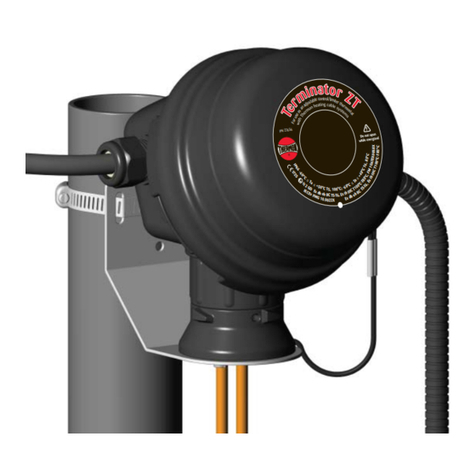
Thermon
Thermon Terminator ZT-P-WP Reference guide
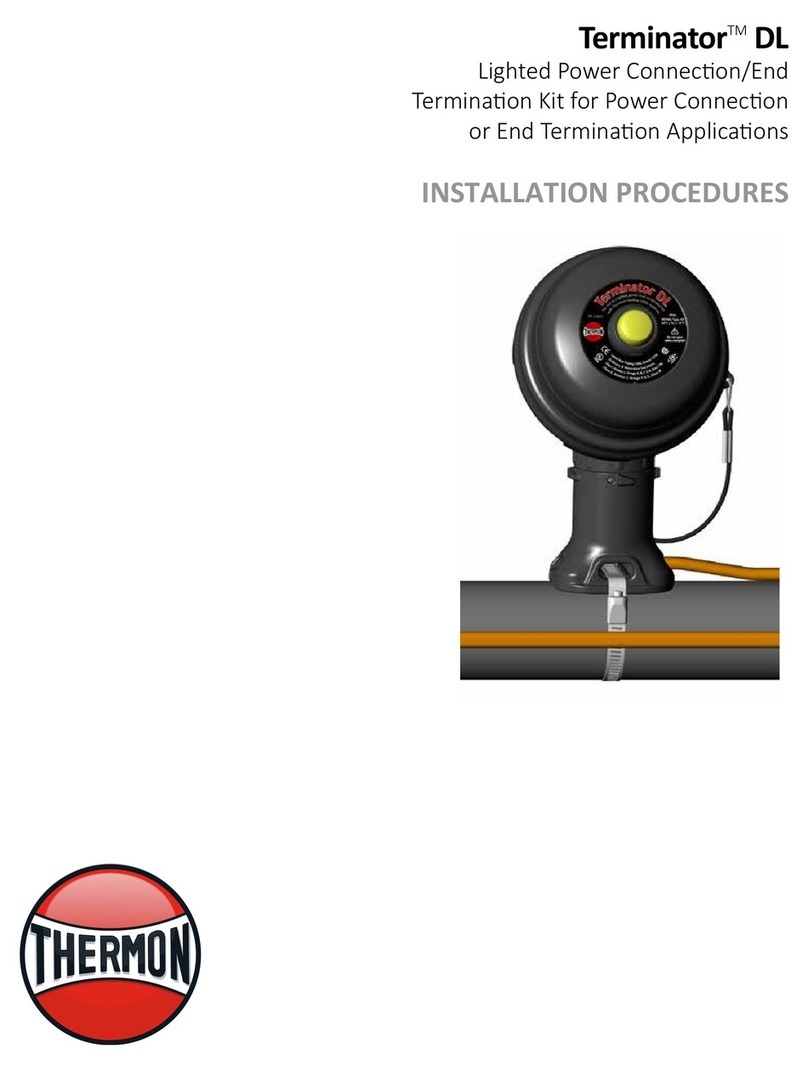
Thermon
Thermon Terminator DL Reference guide

Thermon
Thermon TraceNet ECM-P/FAK-1 Reference guide
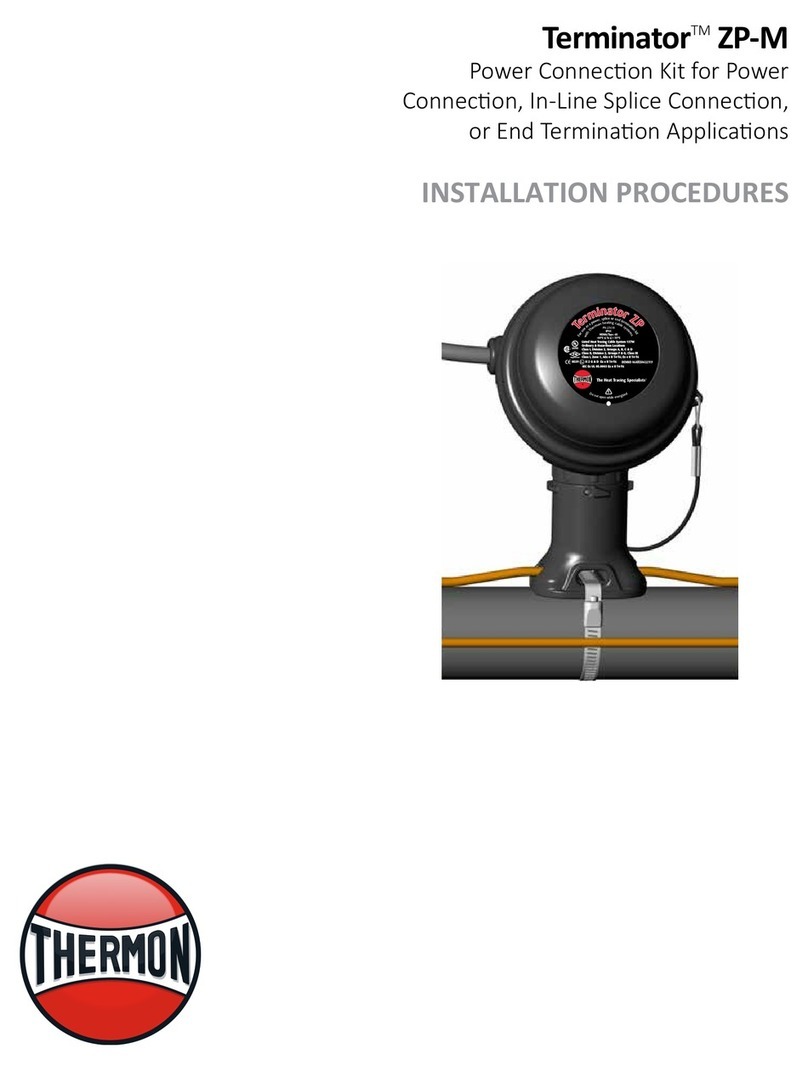
Thermon
Thermon Terminator ZP-M Reference guide
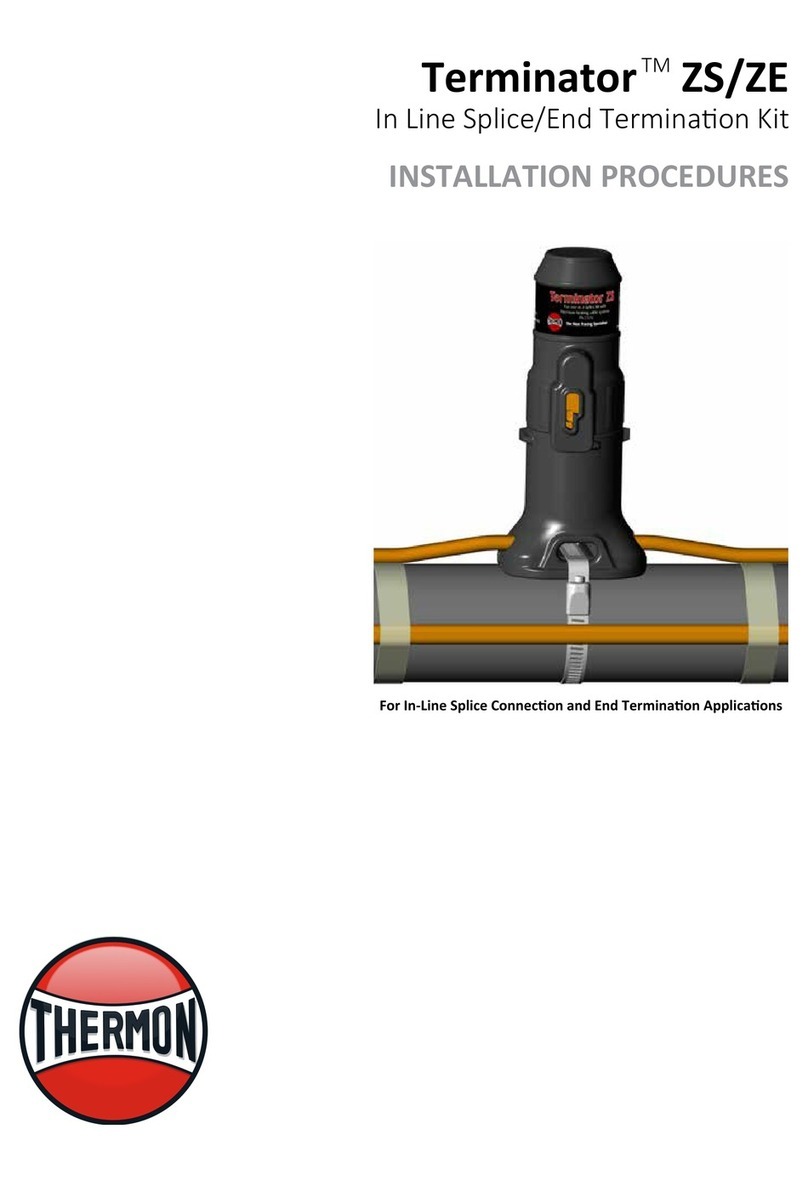
Thermon
Thermon Terminator ZS Reference guide

Thermon
Thermon Terminator DP-M Reference guide

Thermon
Thermon Terminator ZP-XP Reference guide

Thermon
Thermon Terminator ZP Reference guide

Thermon
Thermon Terminator DS/DE Reference guide

Thermon
Thermon Fastrax User manual
